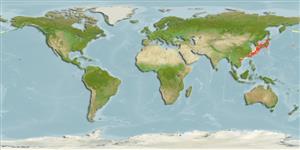Common names from other countries
>
Perciformes/Scorpaenoidei (Scorpionfishes) >
Hoplichthyidae (Ghost flatheads)
Etymology: Hoplichthys: Greek, hoplon = weapon + Greek,ichthys = fish (Ref. 45335).
Eponymy: Baron Georg Heinrich von Langsdorff (otherwise Grigoriy Ivanovich) (1774–1852) was a German physician, botanist, zoologist, traveller, ethnographer and diplomat. [...] (Ref. 128868), visit book page.
More on author: Cuvier.
Environment: milieu / climate zone / profondeur / distribution range
Écologie
marin démersal. Temperate
Northwest Pacific: southern Japan to the East China Sea.
Taille / Poids / Âge
Maturité: Lm ? range ? - ? cm
Max length : 16.0 cm SL mâle / non sexé; (Ref. 559)
Life cycle and mating behavior
Maturité | Reproduction | Frai | Œufs | Fécondité | Larves
Masuda, H., K. Amaoka, C. Araga, T. Uyeno and T. Yoshino, 1984. The fishes of the Japanese Archipelago. Vol. 1. Tokai University Press, Tokyo, Japan. 437 p. (text). (Ref. 559)
Statut dans la liste rouge de l'IUCN (Ref. 130435: Version 2025-1)
Menace pour l'homme
Harmless
Utilisations par l'homme
Outils
Articles particuliers
Télécharger en XML
Sources Internet
Estimates based on models
Preferred temperature (Réf.
123201): 1 - 23, mean 13.5 °C (based on 85 cells).
Phylogenetic diversity index (Réf.
82804): PD
50 = 0.5001 [Uniqueness, from 0.5 = low to 2.0 = high].
Bayesian length-weight: a=0.01000 (0.00244 - 0.04107), b=3.04 (2.81 - 3.27), in cm total length, based on all LWR estimates for this body shape (Ref.
93245).
Niveau trophique (Réf.
69278): 3.6 ±0.4 se; based on size and trophs of closest relatives
Fishing Vulnerability (Ref.
59153): Low vulnerability (10 of 100).
🛈
